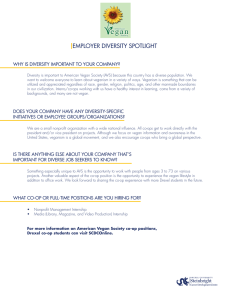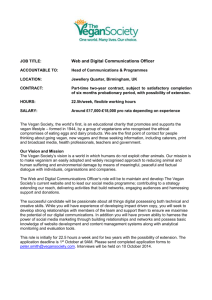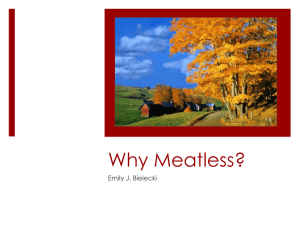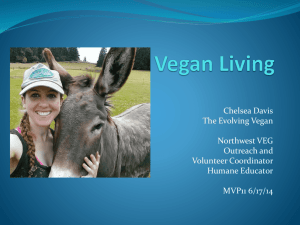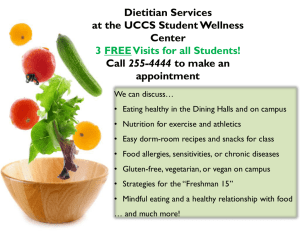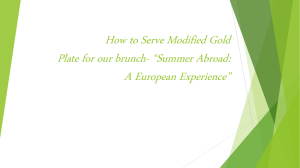The Vegan Challenge: Through Veganism to a Paradigm Change
advertisement
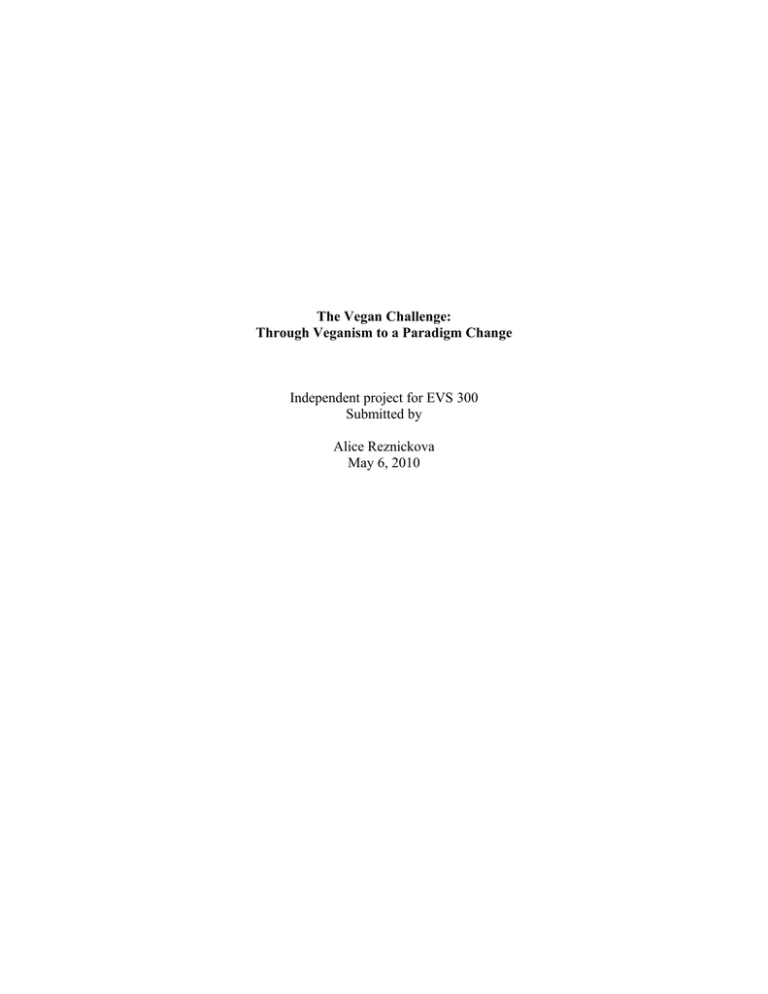
The Vegan Challenge: Through Veganism to a Paradigm Change Independent project for EVS 300 Submitted by Alice Reznickova May 6, 2010 Abstract Environmental degradation is a direct result of our actions based on the current paradigm of having infinite resources to support infinite consumption. The paradigm penetrates our everyday lives; one of its expressions is our diet that is a direct cause of environmental issues. Although animal agriculture is an environmentally devastating industry, it is an industry with the most potential to change in response to consumer demand. To do that, we have to start by changing individual attitudes; such process is facilitated by education, conversation, and experience. The Vegan Challenge was designed to fulfill the three requirements: it educated people about food and an alternative lifestyle as well as new framework for thinking, introduced conversation in form of sharing knowledge and ideas, and experience by becoming vegan for a week with the help of two researchers-supporters. The Vegan Challenge proved to be a great success: not only the participants decreased their environmental impact during the week long study, they also reported a transformation into more conscious and better feeling citizens, who will hopefully pass their experience on in a similar process. Introduction: Need for change Environmental degradation, particularly for its connection to the threat of imminent climate change, has been amongst the globally most discussed topics of the last decade. The most important factor contributing to the degradation is the beliefs, or paradigms, that penetrate our society. ‘Paradigm’ as first introduced by Thomas Kuhn in natural science, is ‘a set of assumptions or a conceptual model about reality that frames or creates the context in which scientists explore data, solve problems, and construct and define theories’ (Manahan, 2006). Handa (1986) applied paradigms to social sciences: paradigms frame our thinking, which is consequently reflected through our behavior. Winter (1996) defines the Western society’s framework by linear thinking. Linear thinking is present in different ideas of our lives, including the economy. Our current economical system, neo-classical economics, is founded on the idea of infinite growth, which is based on the false assumption of having access to infinite resources. In ‘The Tragedy of the Comonds,’ Hardin (1968) illustrates how such an assumption, combined with our greed, leads to exploitation through constant increase in production and consumption, which in turn causes environmental degradation. Linear-thinking is apparent in all aspects of our life; in this case, we will discuss it in connection with eating, an action many people do several times a day without thinking about its large environmental impacts. Although food is so deeply ingrained in our life and we spend a lot of time thinking about it, we are now very removed from the reality of where the food comes from and what it costs to produce a package on a supermarket shelf. To improve our relationship with food and the environment, a change in our current paradigms is required. We often think in terms of small items that can be easily improved: recycling, biking to work, taking shorter showers. Adapting such change for food is more challenging; food touches all areas of our life, it is a social action, a tradition, a ritual. Food connects us to other people and past times of our lives. Giving up food, for whatever reason, is uncomfortable, which is why this conversation is often hard to start. However, the situation has a large potential to improve. Since we consume food daily, a change in a consumer pattern would have to be responded to by the industry immediately. As Robert Kenner, the director of the film Food Inc. (2009) suggests in his film: ‘Every time you pass an item through a register, you vote.’ Let’s talk about food… Food production is associated with a wealth of energy that often comes from unsustainable resources. Other externalities, particularly in the form of environmental degradation, are not included in the cost: pollution of surface and ground water, soil erosion and depletion, acid rain, and others. In attempting to understand which foods are more costly than others, we cannot only look at the supermarket prices; instead, we need to consider other parts of the equation, which in this paper are the fuel cost to produce 1 kcal of protein (protein here stands for all food sources because it is a common nutrient in most foods) and environmental degradation.1 Pimentel (2009) illustrates the trend in energy required to produce animal versus plant products (Table 1). The most energetically demanding protein source is meat: lamb is leading with 57 kcal of energy per 1 kcal of protein followed by beef cattle and eggs with 40 and 39 kcal per 1 kcal/protein respectively. All animal protein is still much less energy-efficient than plant protein, which costs only 2.2 kcal of energy per 1 kcal of protein produced. Similar trends are reported for water resources and land use as well (Pimentel, 2009). From this point of view, a plant based diet is clearly a more responsible choice. Table 1: The amount of energy needed to produce 1 kcal of protein for different animal products compared to a generic plant product (adapted from Pimentel (1992)) Product Lamb Beef Cattle Eggs Swine Dairy (milk) Turkeys Broilers Plants Energy Input to Protein Output (kcal) 57:1 40:1 39:1 14:1 14:1 10:1 4:1 2.2:1 1 Note that we do not consider differences in energy required to produce the final product, for instance the energy necessary to make butter from animal milk and the energy to make vegetable oil. Besides the energy expenditures, there are many other environmental problems associated with raising animals, particularly with livestock. These are investigated and summarized by the latest UN Report on animal agriculture (2006). First, animals need space, which is often taken from areas with high biodiversity, such as the rainforest. According to the UN report, approximately 70% of the Amazon that has been clear-cut in the past serves as pastures for livestock. Such an approach is clearly problematic, because rainforests are the world’s biodiversity hotspots. Furthermore, raising livestock is associated with high levels of soil erosion; it is the single largest contributor to groundwater and soil pollution. Livestock is a large contributor to atmospheric pollution as well: it comprises 64% of all nitrogen emissions and 18% of total greenhouse gas emissions, which is often larger portion of the total emissions than that for transportation. Last, but certainly not least, animal agriculture takes away 8% of the world’s water supply and takes space of more productive plant agriculture, which is a high number considering many places on Earth do not have access to fresh water or food (UN Report, 2006). The solution to the problems with animal products is veganism, a plant based diet. Plants are in general less demanding fuel-wise and less degrading to the environment. A skeptic would point out that this is not always the case: an unwise plant based agriculture can often be threaten the environment as much as animal agriculture does. However, the term vegan does not simply mean a person who avoids all animal products, but an individual who is concerned about the origin of her food and makes smart choices in her consumption. Shifting from not caring what is on one’s plate (as long as it is tasty and contains a large slice of meat) to making wise and informed choices is an example of change in paradigm. How can we achieve such change? Rogers (1983) explains that paradigm shifts start with ‘originators’, who spread their idea to ‘early adopters’ and consequently to ‘early majority’. Such an approach was already successful in the history of the environmental movement once: the term ‘ecosystem’ was coined by Roy Clapham in 1930, yet only in the past 30 or so years became common knowledge (Willis, 1997). Similarly, veganism was officially introduced by Donald Watson in 1944 (Vegan Society, 2010) and in the past 66 years became well-known to the extent that many high protein plan foods can be bought in many supermarket chains and many coffee shop chains offer dairy-free milk (although this is obviously a result of rising lactose intolerance). Historical trends illustrate that paradigm shifts begin with a change in the ‘originator’s’ worldviews, which under favorable circumstances creates a domino effect and shifts worldviews of ‘early adopters’. A small community with a common belief is then established, and, given time, the belief turns into a new paradigm. With some luck and a lot of effort, we will see this happen for environmentalism in our lifetime. Many studies proposed a variety of models of individual environmental worldview formations. Early models were based on a linear progression of increasing knowledge, which allows individuals to attain pro-environmental attitude, turning it later into pro-environmental behavior (Kollmuss et al. 2002). Although the models are complex and situation specific, I believe that environmental education and conversation are presumably the most essential components of all of them. Through education and conversation, originators explain their worldviews to communities, which might as a result follow suggested alternatives to the ‘normative’ worldview. They will than become educators for the ‘early majority’, making education and conversation the most powerful force of change. The importance of education for shifting environmental worldviews has been shown by Monroe (2003), who determined that there is a positive correlation between environmental knowledge and environmental attitudes. Education does not merely mean formal schooling; instead, it can be highly experiential. With such reasoning, we decided to educate people about veganism in an experiential way: The Vegan Challenge. Through education, conversation, and personal experience, we hoped the participants will explore new meal options connected to a new framework, a new paradigm. The Vegan Challenge is a potential catalyst to become more concerned about where our food comes from, what its true cost is, and the environmental consequences associated with food. Since eating is a cultural and social experience, The Vegan Challenge was supposed to bring people with different ideas together to share a new experience and hopefully leave with a different way of looking at life. Some of them may become early adopters and hopefully will, through education and conversation, spread their ideas to the world, which will sooner or later accept the necessary paradigm change. Methods Participants for The Vegan Challenge were recruited verbally from the authors’ friends. The requirements for participation were being over the age of 18 to avoid the necessity of parental consent and the willingness to become vegan for the period of seven days. For obvious purposes, individuals who were already on vegan diet were excluded from the study. Upon agreeing to take a part in the study, the participants were asked to attend an introductory lecture the day before the challenge started, where they were asked to sign a consent form approved by the Institutional Review Board (IRB) and fill out the first survey about their current dietary habits, expectations for the study, and other environmental behaviors (Appendix I). The hour long lecture given by the two researchers was designed to educate the participants about environmental problems associated with animal products, veganism as a more environmentally friendly alternative, and the purpose of the study (Appendix II). Special emphasis was placed on the fact that not completing the Challenge or occasional consumption of animal products is not a failure; instead the Challenge is created to facilitate exploration of a new lifestyle and new food and social experience. The researchers also assured participants of their support by providing their e-mails and phone numbers. In addition, the researchers provided a support blog (http://10dayveganchallenge.blogspot.com), for which they wrote articles about options at Smith College, Northampton, and commented on pressing vegan issues. The participants were asked to anonymously share their experiences as comments on the on-line blog on daily bases. The researchers send out multiple e-mails throughout the course of the study to encourage the participants to continue the challenge and to remind them of the daily posts on the blog. Two weeks after finishing the seven day challenge, the participants were asked to fill an online survey asking about their experience, current dietary choices, and environmental behaviors. Special emphasis was placed on commenting on the experience with the challenge and new attitudes to veganism. The answers were collected and compared with the initial survey. Results Out of the 15 participants who started the challenge and completed the first survey only 13 completed the second survey online. Due to anonymity of both surveys, it was impossible to determine which participants did not complete the second survey. After the challenge, 18% fewer participants considered themselves omnivores than before the challenge (Figure 1). Out of those 18% of participants, 4% reported semivegetarianism and 14% vegetarianism. When the two participants that did not fill the last survey are added to the ‘Omnivore’ category, the vegetarian category still experienced an increase of 7% signifying a change in dietary habits. Figure 1: Dietary habits of participants (expressed in % of participants) prior to and after The Vegan Challenge (semi-vegetarian refers to pescaterians in this case) The results for consumption of animal and vegan products were mixed (Figure 2). The most obvious changes in the animal category were decreases in consumption of ‘Icecream/Yogurt/Butter’ (from 1.4 servings/person/day to 1.0 spd) and ‘Baked goods’ (1.7 spd to 1.4 spd). In the vegan products category, there is a decrease in the ‘Non-dairy milk’ category (1.0 to 0.8 spd), but an increase in ‘Vegan baked goods’ (0.5 to 0.8 spd). Very little or no change happened for meat, milk, cheese, eggs, meat substitute, milk substitute, and non-dairy ice-cream, yogurt and butter. Figure 2: Consumption of animal and vegan products prior to and after The Challenge calculated in servings per person per day (this number was calculated from participants responses to question ‘How many servings of ___ do you have on average every day?’ with the selection of answers being 0, 1-2, and 3+ servings. The final formula was given by the number of people multiplied by the number of servings: for instance (3 people * 0 servings + 10 people * 1.5 serving + 2 people * 3 servings)/15 people total) Slight changes were reported for the number of vegan meals participants consumed per week (Figure 3). The ‘Never’ category decreased by 5%, while the 3-4x and every day categories increased by 4% and 2% respectively. However, if the two missing participants were added to the ‘Never’ category, the results would be reversed: 27% of the participants would have answered ‘Never’ (a 7% increase). Figure 3: Participants response to ‘How many vegan meals per week do you have? (Including restaurants, dining halls, and others)’ prior to and after the Challenge expressed in % of participants When participants assessed their environmentally friendly behavior, in all categories the average score was above ‘Sometimes’. Participants became on average more conscious in almost all categories. Talking about environmental issues and reading environmental news remained the same, while ‘Env. Voting’ (meaning ‘Taking environmental issues into account while voting’) decreased (Figure 4). Recycling and travel were excluded from the analysis due to problems with the follow-up survey set-up. Figure 4: Participants self-assessed environmental behaviors prior and after the challenge indicated on a 1-5 scale (1 = Never, 2 = Rarely, 3 = Sometimes, 4 = Often, 5 = Always; the final value is the average value across participants) In terms of change in personal feelings, half of the participants reported an increase in personal well-being and usefulness (Figure 5). When assessing their health, 4 participants considered it deteriorated, 6 responded no change, and for 3 it improved. Similarly mixed results were reported for satisfaction: two participants’ satisfaction decreased significantly, for 1 it decreased, 4 reported no change and six reported increase. Figure 6: Participants self-assessed feelings in four categories prior and after the challenge (SD = Significantly Decreased, D = Decreased, N = Neutral, I = Increased, SI = Significantly Increased) In total, over 50 written responses were received on the blog and in the surveys. All are relevant to the discussion: the Survey responses can be found on the web address given previously. Discussion: Overall, The Vegan Challenge brought many positive changes for both the participants and the environment. Although numerical results should serve only as a crude guideline for understanding the changes that occurred in participants’ lives due to The Vegan Challenge, they provide a general idea about the positive outcomes supported by the responses on the blog and personal communications. Strictly speaking, the 15 participants significantly decreased their carbon dioxide emissions as well as other environmental impacts during the seven days on vegan diet. The post-Challenge dietary changes indicate that people are now more willing to eat vegan meals and search for non-animal alternatives. The Vegan Challenge allowed people to explore options they did not dare to try before, such as non-dairy baked goods. Several participants reported their liking of non-dairy milks and other non-animal products introduced to them by The Vegan Challenge: ‘I ate soy occasionally in my pre-vegan life, but I've rekindled a taste for soy milk, too.’ or: ‘I think that it's totally doable for me to have a vegan diet a couple of days a week if I have access to vegan food that I like - before I would have guessed that I would have a very hard time giving up any cheese or milk.‘ Although many participants were not too keen on substituting the traditional animal products such as meat, cheese, and eggs by their vegan alternatives, for instance scrambled tofu or tempeh, they remembered the joys of the plant based diet: ‘I love vegetables, which is something I always forget, but veganism reminded me.‘ Although it is difficult to see the shift on the numbers, several people suggested they will continue eating vegan food: ‘I actually really like some vegan alternatives, and I occasionally eat vegan meals (when I can do so in my usual dining halls) because I just feel better afterwards.’ In fact, a month after the challenge one participant reported she was a vegan now and another one is a part-time vegan, commenting that: ‘The last time I drank milk was before the Challenge’. The Vegan Challenge clearly served as a catalyst in discovering new dietary options. From the changes in environmentally conscious behaviors it seems that the participants thought about the impacts of their actions on the environment and began to make wiser decisions. It is necessary to note that while at College, many students do not have an option to make decisions about their energy or water use except on a small scale that consists of changing light bulbs to more efficient ones and taking shorter showers. However, the behavior that is internalized at College might be carried on and later in life it will mean much lower impact on the environment. From our point of view, the most important category is ‘Talking about the environment’. Although there is no total change prior and after the Challenge, the participants commented on the blog that they indeed talk about the environment more, particularly about their food impact: ‘One day at Northrop, a bunch of people who didn't really know each other were at a big table eating. It came up about the vegan challenge and we began a half hour long conversation about how it is an environmental issue, the benefits, the cons etc. It was really cool, that a bunch of Smithies who didn't really know each other were talking about really deep, important things and really thinking about it.’ Since one of the goals of the Vegan Challenge was to raise a conversation about such issues, we considered the participants’ responses a great success. From Rogers’s (1983) simple model it is necessary that people recognize the issues and talk about them, because it is conversation that has the power to convert a minority to a majority. When assessing personal feelings, the results show that becoming vegan made people feel more useful and well. The reported deterioration in health balanced by the same number of health improvement might be due to participants’ different reaction to changes in diet: any change takes time to adapt to. In addition, people who leave animal-based diet for a plantbased diet are often worried about their protein and calcium intakes. The ‘deterioration’ of health might therefore only be an increase in awareness of their own needs. The personal comments on the blog showed exactly that: many people were worried about their nutrients intake, but soon after trying new options they began to feel better: ‘I almost gave up today. When I woke up this morning I felt headachy, tired (even though I'd gotten a lot of sleep for a typical weeknight), slightly nauseous, and weak--I knew I wasn't getting enough protein or diverse kinds of protein. But then I ate a veggie burger at Northrop/Gillett, and it was like magic!’. After some expert advice, many people began to feel better: ‘I think I could have stuck it out for 10 days! Like mentioned above, my health did improve near the end, or at least I became more accustomed to focusing my diet on foods high in protein.’ Another participant became really excited about being vegan: ‘I'll probably eat more vegan foods just because it made me feel a lot healthier than I have recently (more energy, sleeping better)!‘ This suggests that people are worried about changes in diet, but when managed well, there is a general improvement in participants’ self-perceived health. However, many people suggested that veganism at Smith is difficult, since they are not offered that many healthy choices: ‘Anyway, what I'm trying to say is that it's hard keeping up with my other nutrition concerns while being vegan. As others have said, it would be easier if I were cooking for myself than relying on what Smith wants to feed us. Then I would have more control over my options .‘ In addition, personal well-being and personal satisfaction increased, perhaps for the feeling of helping the environment. Overall, The Vegan Challenge meant a general improvement in participants’ personal feelings. Such change is very positive, because only good experience leads to internalizing and passing on the desired behaviors. In addition to lowering their environmental impact, changing somewhat their dietary habits and environmental behaviors, and feeling better, there is something that the numbers will not reveal. This change is, however, the most important and often invisible: the change in perception and attitude. The goal of The Vegan Challenge was to introduce the participants to new experience: an experience of an alternative lifestyle they might now wish to seek by themselves, but that they might enjoy and completely or partially adopt. In this, The Vegan Challenge truly acted as a catalyst: people felt challenged not only to eat vegan, but to start thinking about food: ‘I felt the challenge helped me be more mindful about how i eat and what kind of impact that has on my lifestyle and how other people respond to me. i found myself thinking more about the ways in which people do what they've learned without turning a critical eye on their behavior. I realized the importance of challenging these behaviors and engaging in discussion about ideologies.’ It is now obvious that The Vegan Challenge achieved the goals: it facilitated education about environmental issues, conversation about our food choices and their impacts, changed attitudes of individuals. Becoming vegan and starting to think about food is a one big step for each woman, but it often seems a small step for the planet. However, each individual has the power to contribute to solving insolvable problems of our times, such as changing the current paradigm, and therefore should persevere in raising awareness. Recommendations For individuals ready to take big steps: Veganism is not a diet – it is a lifestyle. Veganism can be uncomfortable, socially unacceptable, and sometimes physically and psychologically difficult. However, both environmental and personal benefits are huge. The first steps in avoiding animal based products is searching for a local vegan community that offers advice and support, because without those people often lose track of their progress and do not discover as many new options as possible. Some of the easiest changes are switching to non-dairy milk and nondairy baked goods. To be satisfied with one’s diet, it is necessary to accept veganism as a unique style, not an alternative to eating animal products: cooking experiments are strongly encouraged. Furthermore, as suggested above, veganism is not only about avoiding animal products, but also about becoming more conscious about food in general. Eating local and organic is one of the best things that can be done to support small-scale family farms and vote to reform our agriculture. In addition, being vegan should mean being loud. Paradigm shift does not happen without education or conversation: such issues should be raised and argued about at every meal for the best effect. For Smith College: Vegan Challenge was a great success on a small scale. We suggest it should be repeated on an all campus or 5-College scale as an introduction to paradigm shifts. To facilitate the week-long event, healthy vegan options should be served in all dining halls along with meat options. In addition, other educational venues, including speakers, should be presented to bring the issues to the student body. Such event would raise a lot of interest in the Smith community and would result not only in significant decrease in carbon dioxide emissions, but also in changes in individual attitudes that will be carried over to student families and friends, and hopefully, through the media, to the wide public. References: Handa, M. L. (1986). Peace paradigm: Transcending Liberal and Marxian paradigms. Paper presented in ‘International Symposium on Science, Technology and Development’, New Delhi, India, March 20-25, 1987. Mimeographed at O.I.S.E., University of Toronto, Canada. Hardin, G. (1968). The Tragedy of the Commons. Science, 162, 1243-1248. Kenner, R. (2008). Food Inc. Magnolia Pictures. Kollmuss, A., & Agyeman, J. (2002). Mind the Gap: Why Do People Act Environmentally and What Are the Barriers to Pro-Environmental Behavior? Environmental Education Research, 8. Kuhn, T. (1962). The Structure of Scientific Revelations. Chicago: University of Chicago Press. Manahan, D. (2006). A Critical Pedagogy of Place: Rethinking the Teaching and Learning of Geography in Higher Education. Dissertation. Davis, CA: University of California. Monroe, M. C. (2003). Two Avenues for Encouraging Conservation Behaviors. Research in Human Ecology,20 (2), 113-125. Pimentel, D.; and Pimentel, M. (2003). Sustainability of Meat-Based and Plant-Based Diet for the Environment. American Journal of Clinical Nutrition, 78 (3), 660-663. Rogers, E. M. (1983). Diffusion of Innovations (3rd ed.). New York: Free Press. United Nations report (2006). Livestock’s Long Shadow: Environmental Issues and Options. Accessed May 1st, 2010 < http://www.fao.org/docrep/010/a0701e/a0701e00.HTM>. Vegan Society. Vegan Society: History. Accessed May 5th, 2010 < http://www.vegansociety.com/about/history.aspx>. Willis, A. J. (1997). The Ecosystem: an Evolving Concept Viewed Historically. Functional Ecology, 11 (2), 268-271. Winter, D. D. (1996). Ecological Psychology: Healing the Split between Planet and Self. New York: Harper Collins. Appendix I: The initial survey 1. How would you describe your current diet? vegetarian semi-vegetarian: type _________________ omnivore 2. Do you have any dietary allergies/restrictions? Yes No If yes, please describe: ______________________________________________ 3. On average, how many times per day do you consume the following: Meat 0 1-2 3 or more Milk 0 1-2 3 or more Cheese 0 1-2 3 or more Ice-cream/yogurt/butter 0 1-2 3 or more Eggs 0 1-2 3 or more Non-vegan baked goods 0 1-2 3 or more Meat substitute 0 1-2 3 or more 0 1-2 0 1-2 3 or more Non-dairy ice-cream/yogurt/butter 0 1-2 3 or more Vegan baked goods 1-2 3 or more Milk substitute Cheese substitute 0 3 or more 4. How many meals per week do you follow vegan diet? (i.e. going to a vegan dining hall, opting for a vegan meal in a restaurant) Never 1-2 3-4 every day 5. What do you anticipace to be the hardest item to give up? ________________________ 6. What do you anticipace to be the easiest item to give up? _________________________ 7. How do you hope to benefit from this challenge? 8. How often do you participace in the following behaviors? (1=Never, 2=Rarely, 3=Sometimes, 4=Often, 5=Always) Recycling 1 2 3 4 5 Conscious travel 1 2 3 4 5 Wise energy use (light, computer, etc.) 1 2 3 4 5 Wise water use (shower, washing dishes, etc.) 1 2 3 4 5 Buying local/organic produce 1 2 3 4 5 Reading environmental news 1 2 3 4 5 Talking to others about environmental issues 1 2 3 4 5 Taking environmental issues into account while voting 1 2 3 4 5 9. Please, feel free to share any other comments with us.
